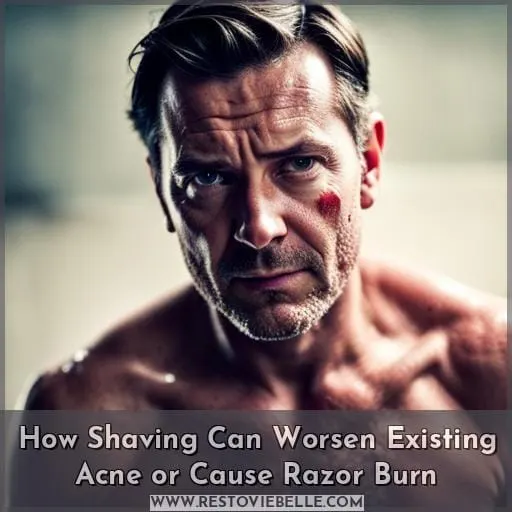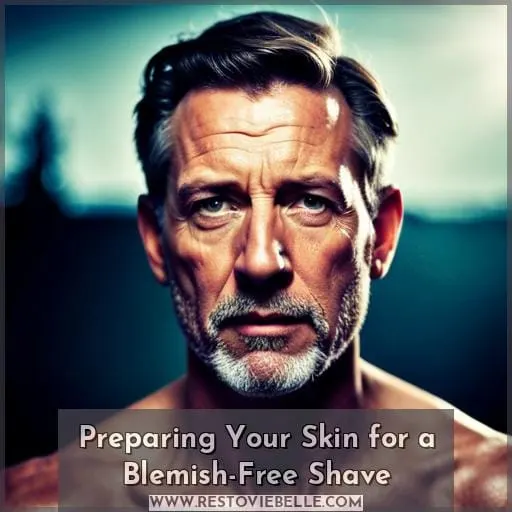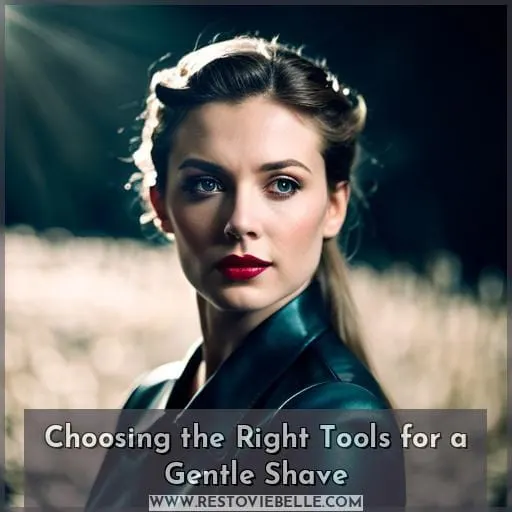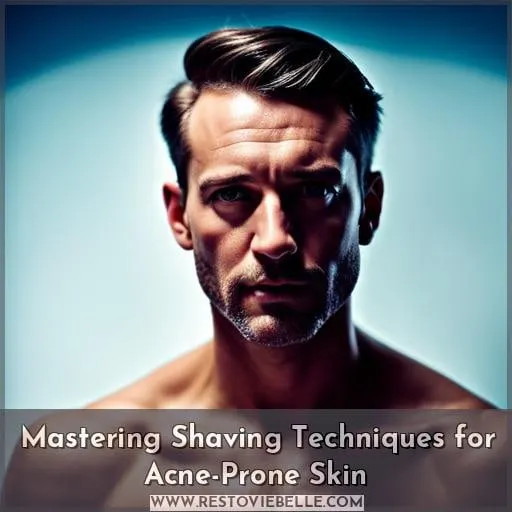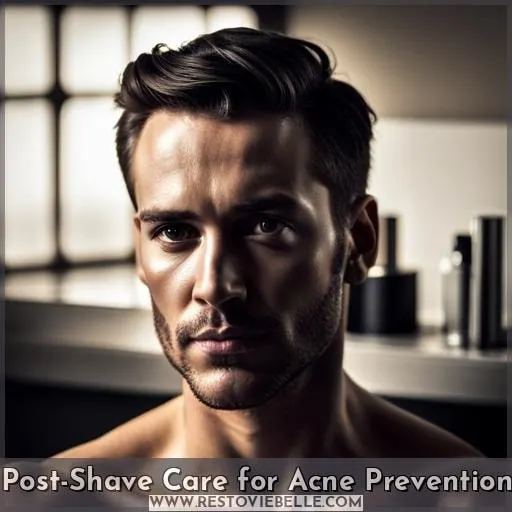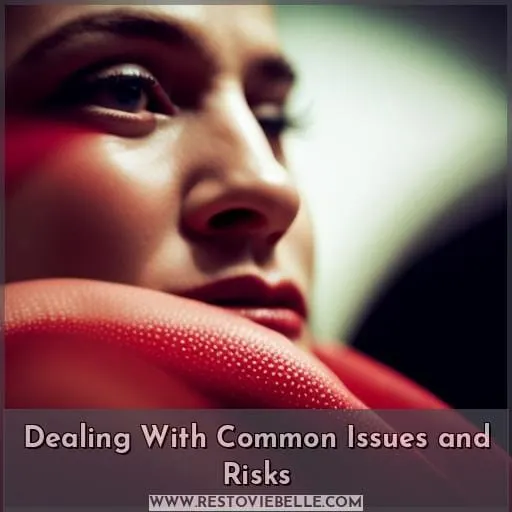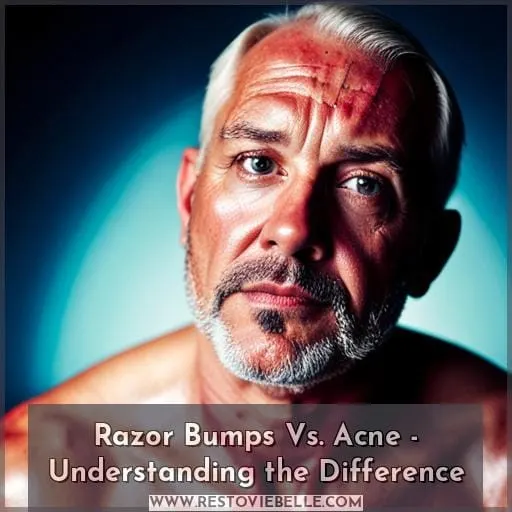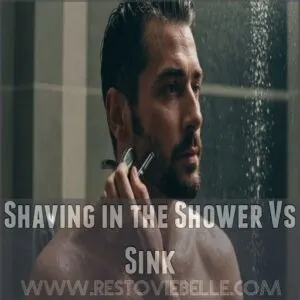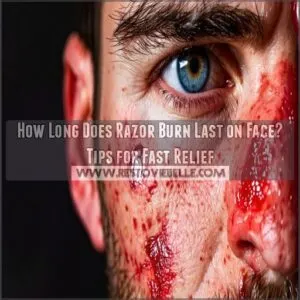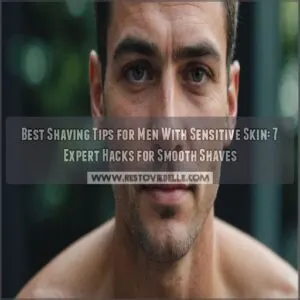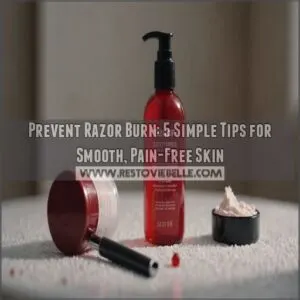This site is supported by our readers. We may earn a commission, at no cost to you, if you purchase through links.
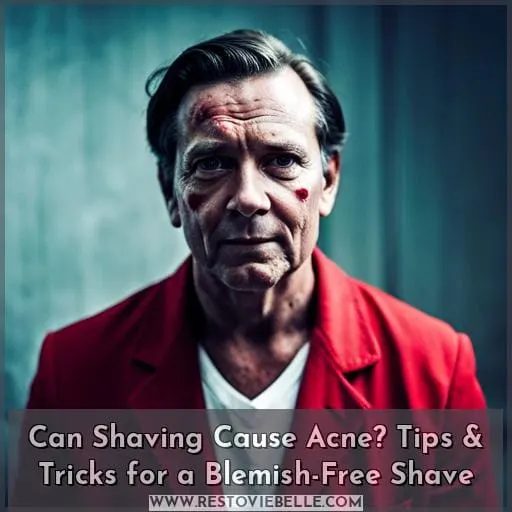 Surprisingly, up to 50% of adults in the U.S. suffer from acne at some point in their life – but can shaving cause it?
Surprisingly, up to 50% of adults in the U.S. suffer from acne at some point in their life – but can shaving cause it?
It’s a common concern for those who shave regularly and want to avoid breakouts, razor burn or worse yet, exacerbating existing issues.
In this article, we will be exploring whether shaving can lead to acne as well as providing tips and tricks on how you can enjoy a blemish-free shave every time using the right tools and techniques specifically designed for sensitive skin.
With an emphasis on prevention rather than cure when it comes to pimples after shaving your face.
Table Of Contents
- Key Takeaways
- Can Shaving Cause Acne?
- How Shaving Can Worsen Existing Acne or Cause Razor Burn
- Preparing Your Skin for a Blemish-Free Shave
- Choosing the Right Tools for a Gentle Shave
- Mastering Shaving Techniques for Acne-Prone Skin
- Post-Shave Care for Acne Prevention
- Dealing With Common Issues and Risks
- Razor Bumps Vs. Acne – Understanding the Difference
- Frequently Asked Questions (FAQs)
- Conclusion
Key Takeaways
- Shaving doesn’t cause acne but can worsen clogged pores.
- Improper shaving leads to razor burn and irritation.
- Incorrect razor use can cause bacteria-caused breakouts.
- Preparation, proper techniques, and suitable products are essential.
Can Shaving Cause Acne?
You may have heard that shaving can worsen existing acne, but it’s important to understand the relationship between shaving and acne in order to prevent breakouts. Shaving doesn’t actually cause acne; instead, it usually exacerbates clogged pores.
Acne arises from hair follicles that become blocked with oil and dead skin cells, resulting in red bumps or pimples on the surface of your skin. When you shave improperly without proper care, this can lead to razor burn or further irritation of already sensitive areas, increasing your risk for outbreaks.
To ensure a blemish-free shave every time, preparation is key. Exfoliating cleansers soften the skin, while moisturizer makes hair pliable, allowing for a closer cut with less tugging. Warm washcloths also aid in softening the skin before using any equipment like razors or electric shavers.
Proper lubrication is necessary as well. Opt for specially formulated gels or creams tailored especially for those who suffer from sensitivity issues related to their complexion. Additionally, always shower beforehand if possible, as this opens up pores and allows for easier access during each stroke of the blade or electric device used.
It’s also important to master techniques, not just when selecting products. Light strokes are encouraged over heavy ones, as too much force could result in more serious damage than just reddened patches along the chin and cheeks.
Shaving against the grain increases the likelihood of ingrown hairs, whereas shaving downwards works best.
Post-shave care shouldn’t be neglected either. Rinse the face off after lathering with plenty of water. Afterwards, a splash of cold water helps close up open facial vessels, thus preventing new irritations caused by potentially odious bacteria left behind when not properly washed upon completion.
Finally, don’t forget to treat the affected area afterward, whether through medicated creams prescribed by a doctor or recommended lotions.
How Shaving Can Worsen Existing Acne or Cause Razor Burn
Falling into the wrong habits while shaving can leave you with an unhappy result—namely, aggravated existing acne or painful razor burn.
- Excessive force when using a sharp razor is likely to irritate the skin and increase sebum production, leading to clogged pores.
- Incorrect use of a single-blade or multi-blade razor makes it easier for bacteria in sweat and oils on the skin surface to block pores, which leads to breakouts.
- Not closing your pores post-shave by rinsing with cold water leaves them vulnerable to dirt buildup that can cause scarring if not treated properly.
- Using a shaving brush without proper lubrication could also cause more irritation, as well as ingrown hairs, which aggravate existing pimples worse than before you shaved!
- The lack of suitable products like moisturizers specifically designed for sensitive skin increases the risk of redness, burning sensations, and stinging pain resulting from dryness caused by excessive friction between the blade and face during shave time.
The key takeaway here is that prevention is better than cure when it comes to maintaining healthy-looking skin after shaving. No matter what type of razor is used (SkinGuard Razor) or facial treatment is followed (men’s acne system), always protect yourself through correct preparation prior to and post-grooming session, plus selecting appropriate tools and products tailored towards avoiding common problems associated with unskilled practices such as those outlined above.
Preparing Your Skin for a Blemish-Free Shave
Preparing for a blemish-free shave is important, especially given the potential risks of worsening existing acne or causing razor burn. To ensure your skin remains healthy and protected during shaving, it’s best to use an exfoliating cleanser beforehand to soften up the skin, apply a moisturizer, and then shower prior to shaving.
Additionally, using proper techniques when performing the actual shave can help reduce irritation and protect against breakouts.
Exfoliating Cleanser and Moisturizer
Before you start shaving, use an exfoliating cleanser to soften the skin and a moisturizer to make the hair pliable for effective removal.
A warm washcloth can help further open pores for a closer shave.
Use an acne-prone skin-friendly shave gel or cream as lubrication and protection.
Opt for a SkinGuard Razor with closely spaced blades if you have sensitive skin. A single-blade razor prevents razor bumps in such cases.
Showering before shaving opens up the pores more effectively than just warm water alone, so prepping your face is essential!
Incorporate these steps into your daily skincare routine to ensure optimal results when managing existing acne while avoiding potential risks like redness, burning, or stinging from improper technique and wrong product selection.
Keep it consistent by replacing razors regularly and sterilizing them after each use.
An appropriate post-shave treatment is also important. Wash off with cold water, then moisturize damp skin followed by a men’s acne treatment system if needed. All of these steps will ensure a healthy-looking, blemish-free shaved look without having to worry about clogged pores again.
Showering Before Shaving
Showering before shaving helps open pores for a closer, smoother shave while minimizing irritation and breakouts.
- Cleanses skin
- Prevents clogged pores
- Reduces infection risk
- Softens hair follicles.
Additionally, consider using products such as an exfoliating cleanser or moisturizer in your skincare kit to prepare the skin further before shaving. To avoid common mistakes that can lead to ingrown hairs and acne scars, use light strokes with a razor and finish off by rinsing face with cold water post-shave; follow up with a hot water rinse if desired.
Taking these steps can ensure you achieve healthy, smooth skin without any blemishes from shaving!
Proper Shaving Techniques
Practicing proper shaving techniques is essential for preventing skin irritation and acne flare-ups. Choose a multi-blade razor with closely spaced blades for minimal irritation, or opt for a SkinGuard Razor to further reduce discomfort.
Use a shave cream or gel specially formulated for acne-prone skin to lubricate and protect the skin from cuts and nicks. Consider using a shaving brush to avoid ingrown hairs. Rinse with cold water after each stroke, then finish off with post-shave moisturizer to soothe the area.
Follow these steps consistently, and you’ll be on your way to achieving smooth, blemish-free results!
Choosing the Right Tools for a Gentle Shave
Choosing the right tools for a gentle shave is essential to prevent acne and irritation. For those with sensitive skin, opting for a SkinGuard Razor can reduce discomfort while multi-blade razors offer close shaves without bumps or razor burn.
However, single-blade razors may be better suited if you’re prone to ingrown hairs. By understanding which techniques are best suited for your skin type, you can get a comfortable shave without exacerbating existing breakouts.
SkinGuard Razor for Sensitive Skin
Opt for a SkinGuard Razor for sensitive skin to reduce irritation and maintain healthy skin – it has multiple blades that are closely spaced together, allowing you to get an even closer shave without affecting your skin.
Here’s what else this razor offers:
- Proper lubrication with acne-friendly gel/cream prevents inflamed or cystic acne breakouts while protecting the delicate skin barrier.
- Blade sterilization is essential before and after each use; rinse off debris between strokes and consider boiling in hot water post-shave if necessary.
- Use light pressure when shaving—especially around any existing pimples—to prevent aggravating breakout areas, as well as ingrown hairs caused by too much force on the blade itself!
Plus, using tea tree oil or benzoyl peroxide pre-shave can help clear up current blemish issues while also helping protect against future outbreaks due to shaving practices!
An effective skincare routine combining proper preparation, proper tools like the SkinGuard Razors along with gentle technique will result in a smooth shave free of blemishes every time!
Multi-Blade Vs. Single-Blade Razor
For acne-prone skin, a multi-blade razor with closely spaced blades is your best bet for minimizing irritation and getting the closest shave. Opting for good blade quality will help you get the most out of each use and ensure that your results last longer.
To prevent ingrown hairs, take care to choose a razor tailored to your skin type and tone. If you have sensitive or dry areas on certain parts of your face, opt for one without synthetic fragrances or other irritants like alcohol in its shave guard formula.
When it comes to technique, be sure not to press too hard against the surface as this can further increase irritation. Light strokes are always preferred with an appropriate amount of pressure when using a single-blade razor over multiple blades.
Lastly, make sure that post-shaving you rinse off any excess hair follicles from the blade before putting it away.
Mastering Shaving Techniques for Acne-Prone Skin
When it comes to shaving with acne-prone skin, the most important techniques are all about direction and pressure. To prevent irritation and razor bumps, shave in any direction, avoiding active pimples while using light strokes for a smooth finish.
Establishing a healthy shaving routine that suits your needs is also key; start by prepping properly before each shave, then follow up post-shave with care such as an aftershave treatment or cold water rinse to close pores.
Shaving Direction and Light Strokes
You want to shave in any direction, using light strokes and avoiding active pimples for a cleaner look without irritation. To achieve this, it’s important to prepare your skin beforehand with an exfoliating cleanser, moisturizer, and warm washcloth.
This will open the pores, making them easier for shaving. Choosing the right razor is critical: multi-blade razors with closely spaced blades are best as they reduce irritation. Single-blade razors can help avoid razor bumps caused by pseudofolliculitis barbae (PFB).
Shave gel or cream should contain skin-soothing ingredients like aloe vera, which protects from seborrheic dermatitis.
Following a Healthy Shaving Routine
Following a consistent routine with the right products and techniques can give you smooth, blemish-free skin in no time! To achieve this goal, use an emollient facial cream for pre-shave preparation. Then, opt for a multi-blade razor to reduce irritation and minimize the risk of razor bumps.
During shaving, be sure to shave lightly against or across the grain – never directly against it – while avoiding existing pimples.
Additionally:
- Replace your blades regularly for optimal hygiene.
- Shower before shaving so pores open up easier.
- Moisturize after each shave to prevent drying out.
- Reduce frequency if mild acne is present.
To maintain healthy skin long term, moisturizing tips should be followed along with using proper technique when grooming. These steps will help keep breakouts at bay without risking further irritation from ill-advised practices such as over-scrubbing or excessively dry shampooing.
With dedication and understanding of how best to care for one’s own body type, acne treatment systems may become unnecessary unless needed due to heavy hormonal activity-related breakouts occurring, which require medical attention instead of home remedies alone.
Post-Shave Care for Acne Prevention
After your shave, it’s important to properly care for your skin. Follow a healthy post-shave routine that includes washing with warm water, moisturizing the damp skin, and using an aftershave treatment to prevent acne breakouts.
Washing and Moisturizing
After you shave, wash your face with warm water and moisturize for softer skin to help prevent acne. Properly washing and moisturizing can reduce skin irritation caused by razor force or red bumps from clogged hair follicles.
Additionally, it’s important to perform regular checks on the areas that are prone to acne development as well as incorporate anti-acne medication into your daily routine.
Lastly, beard oils have been known to decrease inflammation associated with shaving and help keep the area hydrated – a great way of avoiding further issues down the line! By following these tips, you can ensure cleanliness while promoting healthy habits to avoid any potential risks such as exacerbating breakouts or developing scarring over time.
Aftershave Treatment and Cold Water Rinse
It’s important to finish your shave with an aftershave treatment and cold water rinse, just like Jack did when he found his skin was becoming irritated. Aftershaves containing selenium sulfide or hydrocortisone cream help reduce inflammation and irritation from razor force or nicking of the skin.
Pyrithione zinc is another common ingredient in post-shave treatments that can help soothe redness while fighting bacteria associated with acne breakouts.
Shaving frequency should also be adjusted for those prone to irritations as overdoing it could lead to more severe issues down the line requiring a specific acne treatment system for resolution.
Dealing With Common Issues and Risks
Shaving can be a challenge for those with oily and acne-prone skin. To reduce the risks of exacerbating breakouts, using the right tools is essential, such as shaving brushes and proper technique. Sensitivity reactions to improper shaving are also common, which can cause redness, burning, or stinging – even leading to potential scarring if not managed correctly.
Taking careful consideration when choosing products and perfecting your technique will ensure that you have smooth results without any blemishes after every shave.
Oily, Acne-Prone Skin and Shaving Brushes
If you suffer from oily, acne-prone skin, think twice before reaching for a razor. Instead, try using a shaving brush to reduce your risk of ingrown hairs. Proper shaving technique and the right razor choice are essential in minimizing irritation while promoting healthy skin.
Use a SkinGuard Razor for sensitive areas and opt for multi-blade razors with closely spaced blades when possible.
Post shave care is key too. Wash your face with warm water, moisturize damp skin, and then apply an aftershave treatment that’s specifically designed to target oil production or help clear up existing breakouts.
This can include treatments for conditions like Androgenic Alopecia or salicylic acid treatments.
A men’s facial cleanser can also be used alongside beard dandruff shampoo if necessary.
Sensitivity Reactions and Proper Shaving
Be aware that improper shaving can lead to redness, burning, and stinging – making your skin more sensitive. Using the proper tools and applying the appropriate razor force is essential for avoiding irritation and acne scars.
Aftershave treatment with hot water can help reduce potential risks of breakouts or alopecia areata. Incorporating a healthy grooming routine into your lifestyle with a proper shave helps keep sparse hair growth in check, while an effective acne treatment system ensures blemish-free skin.
Risks of Exacerbating Breakouts and Acne Scars
Improper shaving can worsen existing breakouts and even cause acne scarring, so taking care when grooming is essential. Dry-shaving against the grain or too hard increases the risk for razor bumps. Beard bumps may also result from improper skin preparation.
Moisturizing post-shave helps prevent clogged pores that could lead to acne scars.
To avoid these issues, shave in the direction of hair growth with a sharp blade and use an acne treatment system regularly if necessary. If your condition doesn’t improve despite careful shaving during the stubble phase and moisturizing afterward, consider alternatives such as laser hair removal.
Razor Bumps Vs. Acne – Understanding the Difference
Knowing the difference between razor bumps and acne is essential for managing skincare. Razor bumps are caused by ingrown hairs, while acne arises from clogged pores, leading to red bumps on the surface of your skin.
Causes and Characteristics of Razor Bumps
Razor bumps, unlike acne, are caused by ingrown hairs and often appear as small raised red or dark spots on the skin. To prevent irritation when shaving with razor bumps, use a single-blade razor that is closely spaced between blades for a closer shave.
Hydrating creams can also keep ingrown hairs from forming. Sterilizing razors after each use helps avoid clogged pores, which may cause more severe forms of acne than traditional breakouts due to improper shaving techniques, such as in beard transplants where force is used during the procedure.
A proper shave includes pre-shave preparation with an exfoliating cleanser and moisturizer, followed by using an appropriate safe gel or cream for lubrication and protection when actually shaving.
Causes and Characteristics of Acne
Having clear skin requires understanding the difference between razor bumps and acne, as clogged pores are at the root of this common condition. Acne is an inflammatory disorder caused by hormones that increase oil production, leading to clogged pores.
Diet choices can also factor in, as certain foods stimulate inflammation and cause breakouts. Skin cells build up around hair follicles, resulting in red bumps on various skin types, from normal to oily.
To prevent further outbreaks, control hormone levels. Choose a healthy diet. Exfoliate regularly. Use gentle skincare products for your particular skin type. Reduce stress levels and practice relaxation techniques daily.
It’s important to take control of acne before it worsens – proper treatment ensures better chances of healing blemishes quickly without scarring or long-term damage!
Frequently Asked Questions (FAQs)
Are there any skincare products specifically designed for acne-prone skin?
Yes! There are a variety of skincare products specifically designed to help control and manage acne-prone skin. From exfoliating cleansers, moisturizers, razor blades, and gels for shaving, to post-shave treatments – there’s something out there that can work for you.
Choose wisely and look after your skin with the right product selection – it will make all the difference in getting clear skin.
What are the best techniques for avoiding ingrown hairs?
Avoid ingrown hairs while shaving by using a multi-blade razor with closely spaced blades. Always shave in the direction of hair growth, take light strokes, and use appropriate products such as an acne-prone skin-friendly gel or cream for lubrication and protection.
Is it necessary to replace my razor blade every time I shave?
Yes! Replacing your razor blade regularly ensures a smooth, comfortable shave that won’t irritate the skin or cause ingrown hairs.
How often should I shave if I have acne-prone skin?
If you have acne-prone skin, it’s best to shave less often and take extra care with pre-shave preparation. Exfoliating cleansers, warm washcloths, and moisturizers can help soften your skin for a gentle shave.
Avoiding active pimples or using lighter strokes while shaving will also minimize irritation and the risk of razor bumps.
How long do razor bumps usually last?
Razor bumps typically last 24-48 hours, so it’s important to take the right steps to prevent them. Follow proper shaving techniques and use a skin guard razor for sensitive skin to minimize irritation.
Rinse with cold water post-shave and opt for an acne-prone friendly gel/cream lubrication.
Conclusion
Shaving can be a great way to keep your skin looking smooth and blemish-free, but it’s important to understand that it does not cause acne. In fact, acne is caused by clogged hair follicles, whereas improper shaving can worsen existing acne or cause razor burn.
By following a healthy shaving routine with proper pre-shave preparation, choosing the right tools, and post-shave care, you can achieve a smooth and blemish-free shave. Start by exfoliating your skin with a cleanser and moisturizing before shaving. Choose a razor with closely spaced blades and shave in light strokes, following the grain of the hair.
After shaving, rinse with cold water to close the pores and use an aftershave treatment to moisturize and prevent acne. With the right tools and techniques, you can enjoy a comfortable shave free from any blemishes.

